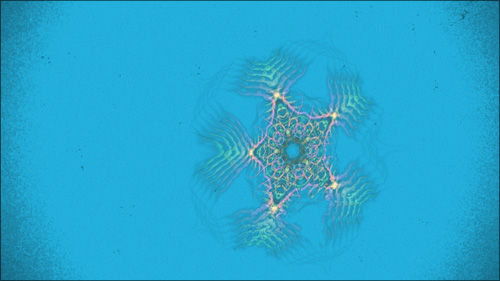Fri 31 Oct 2008
Microspore
Posted by anaglyph under Art, DIY, Ephemera, Mathematics, Science, Work
[29] Comments
I’m working on a new project with my images, this time an animation called Microspore. I wanted to post the moving version up for you to see, but no matter what I do I can’t get it to look presentable, and the full file at proper resolution is far too big for web streaming. Teh internets are cool, but still w-a-a-a-a-y too slow for serious stuff.
Anyways, here are some stills from the film. You’ll have to imagine that you’re looking through a microscope at little critters drifting slowly past.









So you’re the bloke what did diatoms! Next to Slarty Bardfast in the awards line no doubt ;)
lifeforms, tiny little lifeforms.. where are you?
Rev, you know how fast apps are selling for the iphone. I reckon a screensaver…
my usual 10% of course
The King
evenstar: The mice are a lot better at it than me.
Pil: Tiny and pretty!
King Willy: Meh. Everybody & their cat is doing screensavers for the iPhone. I want mine projected on 40m sq walls.
Yea, not to mention it’s already been done.
There ya go. And I bet Will Wright’s already sucked all the money that’s to be had outta that concept.
Yes, he has. But in Will’s defense, I like Spore and Spore Origins on iPhone is fun, too. Unlike so many games for the iPhone, Spore Origins is well polished and entertaining IMHO.
Oh so pretty!
Now, where is that Spray’n’Wipe?
gorgeous reverend. reminds me of some of the photos in the new scientist microscopic pictures award
I’ll think about that 40m projection tomorrow while I’m playing Mahjong! (Guess that’s why you chose white eh Rev – very canny)
The King
Can I vote for a link where we can load the big movie file if we want to?
Pil: I’d love to give you the choice, but the raw animation file is over 10g. Even the best codecs I have destroy all the subtle details and blow out the colours. It’s one of those problems that we have now – you can make things of extraordinary quality, but the tools for getting them out to people are still very severe on subtlety…
Awww! I wanted to see them move. Move… like pretty little living snowflakes. *dreamy look*
PS: Yes, sir! I’m happy to announce that I have all my teeth. That rascally taffy won’t take me down!
It always shocks me whenever you post some of your visual work how absolutely organic mathematical algorithms can look. I would not be shocked to see anything like these in a slide. Well, the pentagonal thing would throw me off.
It makes me think, though, is there any way to account (I’m still not up on what your software is exactly doing) for discrete organic structure? I don’t mean giving the things spleens, just thinking of vascular maps and how they cluster about nodes like kidneys or the brain.
Five-sided creatures are actually quite common in nature, although not so much at the microscopic level, perhaps. But they’re relatively uncomplicated mathematically if you think about it – they’re symmetrical on 3 axes (four if they’re horizontally symmetrical) and both carbon and silicon form bonding structures with five atoms of each quite readily in nature (more so with silicon, which is kind of the conceit of Microspore – a geek joke that I expect very few people to get).
What you’re suggesting with the internal organs is indeed mathematically possible, but not with the apps I use. To form those kinds of structures you need sets of ‘linear consequence’ rules which aren’t readily available in my apps. That would be a rule that would go like this:
•In generation 1 build Block One.
•In generation 2, examine Block One and take some aspect of it and make new blocks with that in mind (option- allow an ‘environmental’ process to effect this step in some way)
•Repeat that process for a certain amount of time, or until a condition is met.
I can almost do this, but I’m limited by mathematical power – I could set up that rule as individual ‘filaments’ but each one would have to be a nested iterative loop which would bring any computer I have to its knees.
When you think about it, though, this is a lot what life is doing, except it has a LOT more time at its disposal. It takes, for instance, nine months to ‘render’ a human being from scratch, and even then its not finished for at least another 18 years or so. Plus, it starts with some cells that have been rendered already, and tweaked to optimization over millions of years.
The app I use to make my work, AMPro, is not specifically designed to do what I do with it. It’s basically a form of programming language for visuals and you can program anything you want with it if there are bits in the tool kit you can use. I have, for instance, built a primitive rule system like the one I suggested above which will form structures that look like coral or ferns. I posted some of those here which you saw, and about which we had a discussion.
One significant bit that’s ‘missing’ from the tool kit, which I’d love Eric Wenger to add, is a kind of ‘natural selection’ component. I don’t expect this to be easy, nor gentle on the CPU, but we have chatted about it. In this way, you could add certain kinds of predetermined ‘environmental’ pressures on the iterative systems which would definitely give a much more ‘lifelike’ outcome. For my own part, I currently use some of the many varieties of ‘noise’ algorithms to achieve this effect, but this is manifestly NOT the way nature does it (or at least not exclusively).
This is where all the Creationists go wrong in appraising nature as ‘not being random’. In the stuff that I’m doing, they are right – I’m playing God and making decisions. If there was an ‘evolutionary pressure’ algorithm available to me, I would explicitly not have to do this – I suggest that once I’d set up a rich rule structure, it would generate all kinds of ‘lifeforms’ that were utterly unpredictable.
I’m sorry, Reverend, I haven’t been over here in too long, we’ve been submerged in work, and this has nothing to do with this post, but I just have to say-
FREE AT LAST! FREE AT LAST! THANK GOD ALMIGHTY, WE’RE FUCKING FREE AT LAST!!
BWAHAHAHAHAHAHAH!!!!!!!!!!!!!!!!
ok, thank you. I needed that.
Colonel, I completely understand.
Me too, best news we’ve had from The States in a very very very long time…
It’s funny Rev, if I hadn’t read Steven (Stephen?) Levy’s Artificial Life, books on Chaos theory/Complexity, Greg Egan, and New Scientist all these years, I wouldn’t have understood a thing you wrote. As it is it’s all crystal clear – ain’t (Artificial) life grand.
I remember having a real “Aha” moment when I first found out about auto-catalytic sets and iteration – closest thing to a spiritual feeling his majesty has ever had…
And it explained the video feedback in the original title sequence of Dr Who at long last – bugger the origins of life.
I’m so glad you’re doing this stuff, and like mathematics – it sure is beautiful!
The (Happy) King
Was that a joke about the “One significant bit that’s ‘missing’”
Oh you’re too much
Court Jester
I could swear I ran across that third one drinking scotch in a bar downtown last weekend.
that looks awesome! is there anywhere we can see them online? YouTube of some sort?
I would love to see those images on 40 sq m walls …or larger!
Hi all – things will be erratic on The Cow for a bit as I’ve just touched down in LA for a stretch of work. Normal transmission will resume when I have recovered from jet and acclimatization lag.
treespotter: We will have them up in the U&I Software Chill Room pretty soon. I will put up a link when done!
meggie: You don’t happen to be a filthy-rich billionaire do you? We could make it happen!
Salut all!
I hope the Cavity Search Robot was kind upon your arrival at LAX.
Good luck with the job, I’m sure it’ll be fun, we promise to look after Violet Towne when she comes a visitin’.
The King
Thanks King Willy! Don’t lead her astray.
You know, I’ve been really interested lately in how time changes what we perceive as rules. The way I deal with it mostly is in the area of rocks, obviously. Rocks have zero strength when dealing with the (almost) infinitely slow strain rates of gravity. The rocks behave fluidly under the low energy and high time of gravity. You see this in old windows, too. They get thicker at the bottom and in some cases shrink away from the tops of their frames.
I think you could argue that time serves an analogous role in EVILution. The same thing that makes a marble gravestone distort and crush and flatten out like silly putty left out in a warm room can subtly but powerfully make impossible selection mechanisms as potent as gravity.
Were you to model it, you would almost have to model a time machine. In other words, throw in selecting mechanisms billions of times every second for hours, days or weeks if you wanted to really mind fuck yourself.
Which is exciting because:
The internet does just that (dubious use of active verb) to itself everyday. Even at this point, certain behaviors are emerging, created to a point by humans and selected by them, but not evolving predictably. It isn’t SkyNet or anything like that, but it is truly amazing to me that we have a real, no shit analog to evolution (would old websites whose plugins don’t work be a different species?) happening right in front of us.
Pretty. :)
Casey: I think I predicted some time back (What I Believe But Cannot Prove) that there would be a point where we would see spontaneous ordered behaviour arise from the internet that was surprising and unpredictable. What I mean by that is that the net will start and do things that it wasn’t explicitly created to do. By itself.
I don’t mean to suggest that it will ‘become aware’, necessarily, but just that we will see emergent behaviour that will catch us off guard – possibly even frighten us. In fact, I will be astonished if it doesn’t happen – it’s a complex emergent system, and if it follows the normal path of such things, then self-created behaviour necessarily follows….